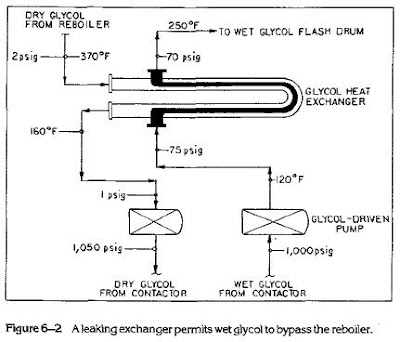A higher temperature in the top of the still column can increase glycol losses due to excessive vaporization. The boiling point of water is 212°F and the boiling point of TEG is 546°R The recommended temperature in the top of the still column is approximately 225°F. When the temperature exceeds 250°F the glycol vaporization losses may become substantial. The still top temperature can be lowered by increasing the amount of glycol flowing through the reflux coil.
If the temperature in the top of the still column gets too low, too much water can be condensed and increase the reboiler heat load. Too much cool glycoi circulation in the reflux coil can sometimes lower the still top temperature below 220°F. Thus, most reflux coils have a bypass to allow manual or automatic control of the stripping still temperature.
Stripping gas will have the effect of requiring reduced top still temperature to produce the same reflux rate.

